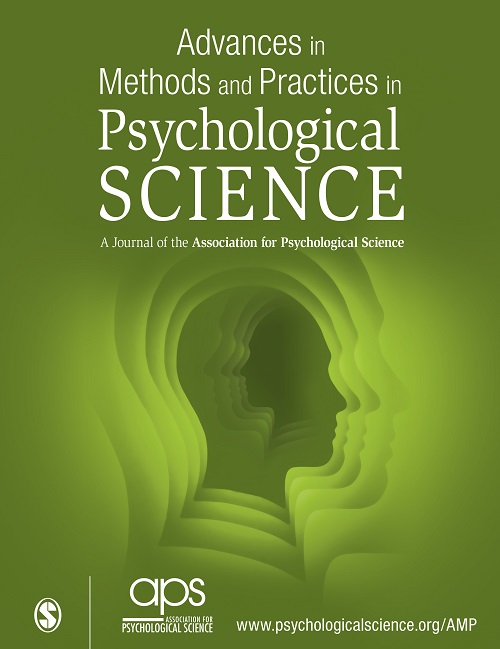How Many Participants Do I Need to Test an Interaction? Conducting an Appropriate Power Analysis and Achieving Sufficient Power to Detect an Interaction
IF 13.4
1区 心理学
Q1 PSYCHOLOGY
Advances in Methods and Practices in Psychological Science
Pub Date : 2023-07-01
DOI:10.1177/25152459231178728
引用次数: 11
Abstract
Power analysis for first-order interactions poses two challenges: (a) Conducting an appropriate power analysis is difficult because the typical expected effect size of an interaction depends on its shape, and (b) achieving sufficient power is difficult because interactions are often modest in size. This article consists of three parts. In the first part, we address the first challenge. We first use a fictional study to explain the difference between power analyses for interactions and main effects. Then, we introduce an intuitive taxonomy of 12 types of interactions based on the shape of the interaction (reversed, fully attenuated, partially attenuated) and the size of the simple slopes (median, smaller, larger), and we offer mathematically derived sample-size recommendations to detect each interaction with a power of .80/.90/.95 (for two-tailed tests in between-participants designs). In the second part, we address the second challenge. We first describe a preregistered metastudy (159 studies from recent articles in influential psychology journals) showing that the median power to detect interactions of a typical size is .18. Then, we use simulations (≈900,000,000 data sets) to generate power curves for the 12 types of interactions and test three approaches to increase power without increasing sample size: (a) preregistering one-tailed tests (+21% gain), (b) using a mixed design (+75% gain), and (c) preregistering contrast analysis for a fully attenuated interaction (+62% gain). In the third part, we introduce INT×Power ( www.intxpower.com ), a web application that enables users to draw their interaction and determine the sample size needed to reach the power of their choice with the option of using/combining these approaches.我需要多少参与者来测试一个交互?进行适当的功率分析并获得足够的功率来检测相互作用
一阶相互作用的功率分析提出了两个挑战:(a)进行适当的功率分析是困难的,因为相互作用的典型预期效应大小取决于其形状;(b)获得足够的功率是困难的,因为相互作用的大小通常是适度的。本文由三部分组成。在第一部分中,我们解决了第一个挑战。我们首先使用一个虚构的研究来解释相互作用和主要效应的功效分析之间的差异。然后,我们根据相互作用的形状(反向、完全衰减、部分衰减)和简单斜率(中位数、较小、较大)的大小,引入了12种相互作用的直观分类,并提供了数学推导的样本大小建议,以0.80 / 0.90 / 0.95的功率检测每种相互作用(用于参与者之间设计的双尾测试)。在第二部分中,我们将讨论第二个挑战。我们首先描述了一项预登记的转移研究(来自有影响力的心理学期刊最近文章的159项研究),表明检测典型大小的相互作用的中位功率为0.18。然后,我们使用模拟(≈900,000,000数据集)生成12种相互作用的功率曲线,并测试三种方法在不增加样本量的情况下增加功率:(a)预注册单侧测试(+21%增益),(b)使用混合设计(+75%增益),以及(c)预注册完全衰减相互作用的对比分析(+62%增益)。在第三部分中,我们将介绍INT×Power (www.intxpower.com),这是一个web应用程序,它使用户能够绘制他们的交互并确定所需的样本量,以便通过使用/组合这些方法来实现他们的选择。
本文章由计算机程序翻译,如有差异,请以英文原文为准。
求助全文
约1分钟内获得全文
求助全文
来源期刊
CiteScore
21.20
自引率
0.70%
发文量
16
期刊介绍:
In 2021, Advances in Methods and Practices in Psychological Science will undergo a transition to become an open access journal. This journal focuses on publishing innovative developments in research methods, practices, and conduct within the field of psychological science. It embraces a wide range of areas and topics and encourages the integration of methodological and analytical questions.
The aim of AMPPS is to bring the latest methodological advances to researchers from various disciplines, even those who are not methodological experts. Therefore, the journal seeks submissions that are accessible to readers with different research interests and that represent the diverse research trends within the field of psychological science.
The types of content that AMPPS welcomes include articles that communicate advancements in methods, practices, and metascience, as well as empirical scientific best practices. Additionally, tutorials, commentaries, and simulation studies on new techniques and research tools are encouraged. The journal also aims to publish papers that bring advances from specialized subfields to a broader audience. Lastly, AMPPS accepts Registered Replication Reports, which focus on replicating important findings from previously published studies.
Overall, the transition of Advances in Methods and Practices in Psychological Science to an open access journal aims to increase accessibility and promote the dissemination of new developments in research methods and practices within the field of psychological science.

 求助内容:
求助内容: 应助结果提醒方式:
应助结果提醒方式:


